Sha Li
FanChuan: A Multilingual and Graph-Structured Benchmark For Parody Detection and Analysis
Feb 23, 2025



Abstract:Parody is an emerging phenomenon on social media, where individuals imitate a role or position opposite to their own, often for humor, provocation, or controversy. Detecting and analyzing parody can be challenging and is often reliant on context, yet it plays a crucial role in understanding cultural values, promoting subcultures, and enhancing self-expression. However, the study of parody is hindered by limited available data and deficient diversity in current datasets. To bridge this gap, we built seven parody datasets from both English and Chinese corpora, with 14,755 annotated users and 21,210 annotated comments in total. To provide sufficient context information, we also collect replies and construct user-interaction graphs to provide richer contextual information, which is lacking in existing datasets. With these datasets, we test traditional methods and Large Language Models (LLMs) on three key tasks: (1) parody detection, (2) comment sentiment analysis with parody, and (3) user sentiment analysis with parody. Our extensive experiments reveal that parody-related tasks still remain challenging for all models, and contextual information plays a critical role. Interestingly, we find that, in certain scenarios, traditional sentence embedding methods combined with simple classifiers can outperform advanced LLMs, i.e. DeepSeek-R1 and GPT-o3, highlighting parody as a significant challenge for LLMs.
The Law of Knowledge Overshadowing: Towards Understanding, Predicting, and Preventing LLM Hallucination
Feb 22, 2025



Abstract:Hallucination is a persistent challenge in large language models (LLMs), where even with rigorous quality control, models often generate distorted facts. This paradox, in which error generation continues despite high-quality training data, calls for a deeper understanding of the underlying LLM mechanisms. To address it, we propose a novel concept: knowledge overshadowing, where model's dominant knowledge can obscure less prominent knowledge during text generation, causing the model to fabricate inaccurate details. Building on this idea, we introduce a novel framework to quantify factual hallucinations by modeling knowledge overshadowing. Central to our approach is the log-linear law, which predicts that the rate of factual hallucination increases linearly with the logarithmic scale of (1) Knowledge Popularity, (2) Knowledge Length, and (3) Model Size. The law provides a means to preemptively quantify hallucinations, offering foresight into their occurrence even before model training or inference. Built on overshadowing effect, we propose a new decoding strategy CoDa, to mitigate hallucinations, which notably enhance model factuality on Overshadow (27.9%), MemoTrap (13.1%) and NQ-Swap (18.3%). Our findings not only deepen understandings of the underlying mechanisms behind hallucinations but also provide actionable insights for developing more predictable and controllable language models.
Oreo: A Plug-in Context Reconstructor to Enhance Retrieval-Augmented Generation
Feb 20, 2025Abstract:Despite the remarkable capabilities of Large Language Models (LLMs) in various NLP tasks, they remain vulnerable to hallucinations due to their limited parametric knowledge and lack of domain-specific expertise. Retrieval-Augmented Generation (RAG) addresses this challenge by incorporating external document retrieval to augment the knowledge base of LLMs. In this approach, RAG retrieves document chunks from an external corpus in response to a query, which are then used as context for the downstream language model to generate an answer. However, these retrieved knowledge sources often include irrelevant or erroneous information, undermining the effectiveness of RAG in downstream tasks. To overcome this limitation, we introduce a compact, efficient, and pluggable module designed to refine external knowledge sources before feeding them to the generator. The module reconstructs retrieved content by extracting the most relevant and supportive information and reorganising it into a concise, query-specific format. Through a three-stage training paradigm - comprising supervised fine-tuning, contrastive multi-task learning, and reinforcement learning-based alignment - it prioritises critical knowledge and aligns it with the generator's preferences. This method enables LLMs to produce outputs that are more accurate, reliable, and contextually appropriate.
SyncMind: Measuring Agent Out-of-Sync Recovery in Collaborative Software Engineering
Feb 10, 2025Abstract:Software engineering (SE) is increasingly collaborative, with developers working together on shared complex codebases. Effective collaboration in shared environments requires participants -- whether humans or AI agents -- to stay on the same page as their environment evolves. When a collaborator's understanding diverges from the current state -- what we term the out-of-sync challenge -- the collaborator's actions may fail, leading to integration issues. In this work, we introduce SyncMind, a framework that systematically defines the out-of-sync problem faced by large language model (LLM) agents in collaborative software engineering (CSE). Based on SyncMind, we create SyncBench, a benchmark featuring 24,332 instances of agent out-of-sync scenarios in real-world CSE derived from 21 popular GitHub repositories with executable verification tests. Experiments on SyncBench uncover critical insights into existing LLM agents' capabilities and limitations. Besides substantial performance gaps among agents (from Llama-3.1 agent <= 3.33% to Claude-3.5-Sonnet >= 28.18%), their consistently low collaboration willingness (<= 4.86%) suggests fundamental limitations of existing LLM in CSE. However, when collaboration occurs, it positively correlates with out-of-sync recovery success. Minimal performance differences in agents' resource-aware out-of-sync recoveries further reveal their significant lack of resource awareness and adaptability, shedding light on future resource-efficient collaborative systems. Code and data are openly available on our project website: https://xhguo7.github.io/SyncMind/.
Schema-Guided Culture-Aware Complex Event Simulation with Multi-Agent Role-Play
Oct 24, 2024



Abstract:Complex news events, such as natural disasters and socio-political conflicts, require swift responses from the government and society. Relying on historical events to project the future is insufficient as such events are sparse and do not cover all possible conditions and nuanced situations. Simulation of these complex events can help better prepare and reduce the negative impact. We develop a controllable complex news event simulator guided by both the event schema representing domain knowledge about the scenario and user-provided assumptions representing case-specific conditions. As event dynamics depend on the fine-grained social and cultural context, we further introduce a geo-diverse commonsense and cultural norm-aware knowledge enhancement component. To enhance the coherence of the simulation, apart from the global timeline of events, we take an agent-based approach to simulate the individual character states, plans, and actions. By incorporating the schema and cultural norms, our generated simulations achieve much higher coherence and appropriateness and are received favorably by participants from a humanitarian assistance organization.
Establishing Knowledge Preference in Language Models
Jul 17, 2024Abstract:Language models are known to encode a great amount of factual knowledge through pretraining. However, such knowledge might be insufficient to cater to user requests, requiring the model to integrate external knowledge sources and adhere to user-provided specifications. When answering questions about ongoing events, the model should use recent news articles to update its response; when asked to provide recommendations, the model should prioritize user specifications over retrieved product reviews; when some facts are edited in the model, the updated facts should override all prior knowledge learned by the model even if they are conflicting. In all of the cases above, the model faces a decision between its own parametric knowledge, (retrieved) contextual knowledge, and user instruction knowledge. In this paper, we (1) unify such settings into the problem of knowledge preference and define a three-level preference hierarchy over these knowledge sources; (2) compile a collection of existing datasets IfQA, MQuAKE, and MRQA covering a combination of settings (with/without user specifications, with/without context documents) to systematically evaluate how well models obey the intended knowledge preference; and (3) propose a dataset synthesis method that composes diverse question-answer pairs with user assumptions and related context to directly fine-tune LMs for instilling the hierarchy of knowledge. We demonstrate that a 7B model, fine-tuned on only a few thousand examples automatically generated by our proposed method, effectively achieves superior performance (more than 18% improvement across all evaluation benchmarks) in adhering to the desired knowledge preference hierarchy.
Knowledge Overshadowing Causes Amalgamated Hallucination in Large Language Models
Jul 10, 2024Abstract:Hallucination is often regarded as a major impediment for using large language models (LLMs), especially for knowledge-intensive tasks. Even when the training corpus consists solely of true statements, language models still generate hallucinations in the form of amalgamations of multiple facts. We coin this phenomenon as ``knowledge overshadowing'': when we query knowledge from a language model with multiple conditions, some conditions overshadow others, leading to hallucinated outputs. This phenomenon partially stems from training data imbalance, which we verify on both pretrained models and fine-tuned models, over a wide range of LM model families and sizes.From a theoretical point of view, knowledge overshadowing can be interpreted as over-generalization of the dominant conditions (patterns). We show that the hallucination rate grows with both the imbalance ratio (between the popular and unpopular condition) and the length of dominant condition description, consistent with our derived generalization bound. Finally, we propose to utilize overshadowing conditions as a signal to catch hallucination before it is produced, along with a training-free self-contrastive decoding method to alleviate hallucination during inference. Our proposed approach showcases up to 82% F1 for hallucination anticipation and 11.2% to 39.4% hallucination control, with different models and datasets.
MACAROON: Training Vision-Language Models To Be Your Engaged Partners
Jun 20, 2024Abstract:Large vision-language models (LVLMs), while proficient in following instructions and responding to diverse questions, invariably generate detailed responses even when questions are ambiguous or unanswerable, leading to hallucinations and bias issues. Thus, it is essential for LVLMs to proactively engage with humans to ask for clarifications or additional information for better responses. In this study, we aim to shift LVLMs from passive answer providers to proactive engaged partners. We begin by establishing a three-tiered hierarchy for questions of invalid, ambiguous, and personalizable nature to measure the proactive engagement capabilities of LVLMs. Utilizing this hierarchy, we create PIE, (ProactIve Engagement Evaluation) through GPT-4o and human annotators, consisting of 853 questions across six distinct, fine-grained question types that are verified by human annotators and accompanied with well-defined metrics. Our evaluations on \benchmark indicate poor performance of existing LVLMs, with the best-performing open-weights model only achieving an Aggregate Align Rate (AAR) of 0.28. In response, we introduce MACAROON, self-iMaginAtion for ContrAstive pReference OptimizatiON, which instructs LVLMs to autonomously generate contrastive response pairs for unlabeled questions given the task description and human-crafted criteria. Then, the self-imagined data is formatted for conditional reinforcement learning. Experimental results show MACAROON effectively improves LVLMs' capabilities to be proactively engaged (0.84 AAR) while maintaining comparable performance on general tasks.
EVEDIT: Event-based Knowledge Editing with Deductive Editing Boundaries
Feb 17, 2024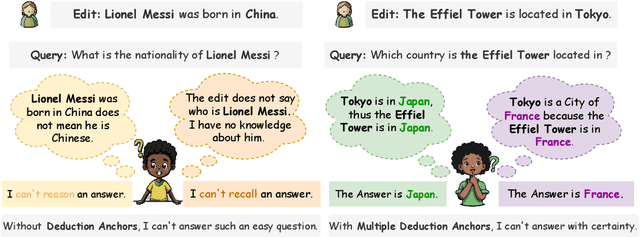

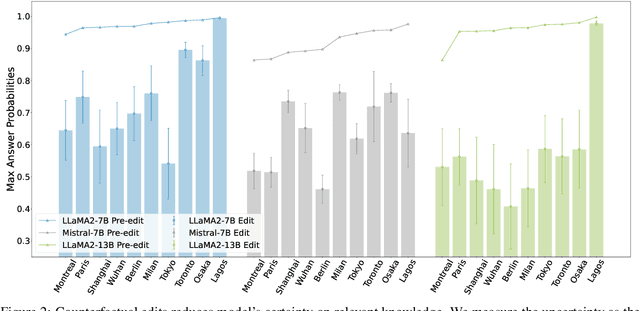

Abstract:The dynamic nature of real-world information necessitates efficient knowledge editing (KE) in large language models (LLMs) for knowledge updating. However, current KE approaches, which typically operate on (subject, relation, object) triples, ignore the contextual information and the relation among different knowledge. Such editing methods could thus encounter an uncertain editing boundary, leaving a lot of relevant knowledge in ambiguity: Queries that could be answered pre-edit cannot be reliably answered afterward. In this work, we analyze this issue by introducing a theoretical framework for KE that highlights an overlooked set of knowledge that remains unchanged and aids in knowledge deduction during editing, which we name as the deduction anchor. We further address this issue by proposing a novel task of event-based knowledge editing that pairs facts with event descriptions. This task manifests not only a closer simulation of real-world editing scenarios but also a more logically sound setting, implicitly defining the deduction anchor to address the issue of indeterminate editing boundaries. We empirically demonstrate the superiority of event-based editing over the existing setting on resolving uncertainty in edited models, and curate a new benchmark dataset EvEdit derived from the CounterFact dataset. Moreover, while we observe that the event-based setting is significantly challenging for existing approaches, we propose a novel approach Self-Edit that showcases stronger performance, achieving 55.6% consistency improvement while maintaining the naturalness of generation.
If LLM Is the Wizard, Then Code Is the Wand: A Survey on How Code Empowers Large Language Models to Serve as Intelligent Agents
Jan 08, 2024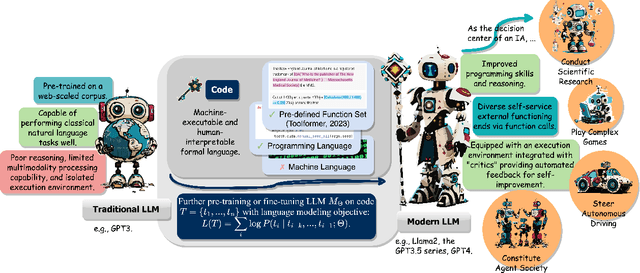

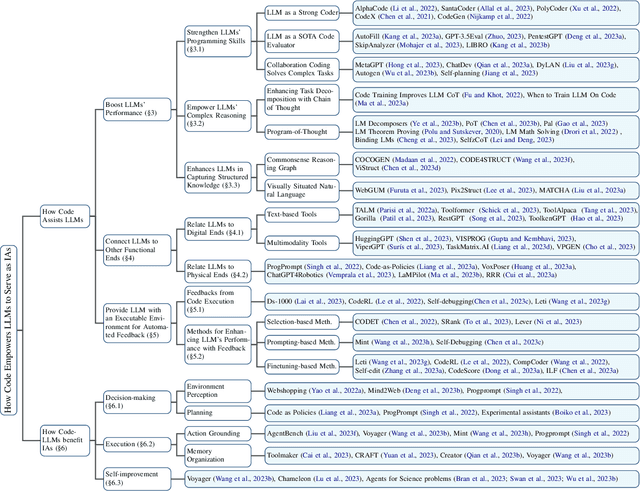
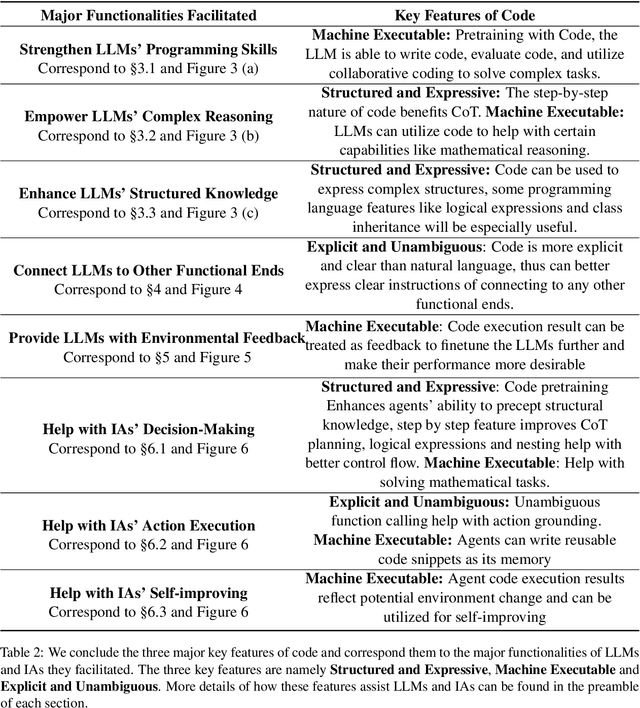
Abstract:The prominent large language models (LLMs) of today differ from past language models not only in size, but also in the fact that they are trained on a combination of natural language and formal language (code). As a medium between humans and computers, code translates high-level goals into executable steps, featuring standard syntax, logical consistency, abstraction, and modularity. In this survey, we present an overview of the various benefits of integrating code into LLMs' training data. Specifically, beyond enhancing LLMs in code generation, we observe that these unique properties of code help (i) unlock the reasoning ability of LLMs, enabling their applications to a range of more complex natural language tasks; (ii) steer LLMs to produce structured and precise intermediate steps, which can then be connected to external execution ends through function calls; and (iii) take advantage of code compilation and execution environment, which also provides diverse feedback for model improvement. In addition, we trace how these profound capabilities of LLMs, brought by code, have led to their emergence as intelligent agents (IAs) in situations where the ability to understand instructions, decompose goals, plan and execute actions, and refine from feedback are crucial to their success on downstream tasks. Finally, we present several key challenges and future directions of empowering LLMs with code.
 Add to Chrome
Add to Chrome Add to Firefox
Add to Firefox Add to Edge
Add to Edge